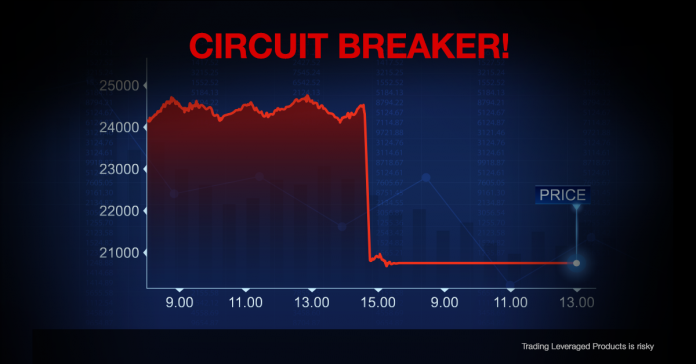The FOMC’s historic reactions to the COVID-19 spread, with its emergency 100 bp rate cut on Monday 16th of March pledging infinite liquidity, did nothing to soothe investor worries, and indeed may have sharpen recession concerns. Those fears, along with Fed coupon purchases, underpinned a strong bid in Treasuries which saw yields from the belly outward richen over 20 bps.
Hence Monday’s opening was delayed as the indexes were limit down. After the FOMC’s action, the USA30 posted its largest point decline in history, sliding -2997 points (-12.9%), and the USA500 fell 11.5%, both triggering an automatic 15-minute halt. This is the third time in the past two weeks that major US and foreign indices hit their emergency circuit breaker as the market opened; this isn’t the first time that a market has been halted due to massive volatility, however it is not something that you see often. Last time it was the turmoil of the 2008 housing crisis that put the country into recession.
But what is a circuit breaker and how does it work?
Circuit breakers were introduced to prevent another event like the Black Monday of 1987, when the Dow Jones fell by 22.6%, in a single trading day, by pausing trading if the S&P 500 price falls too low.
After being tested for the first time in 1997, they were triggered again in March 2020. So, why did that happen and how do circuit breakers work?
What are circuit breakers?
Circuit breakers, which are calculated daily, are set at 7%, 13% and 20% of the closing price of the S&P500 for the previous day. If the price drops 7% in a single session, trading is halted for 15 minutes, and, depending on what happens next, trading may be halted again temporarily or for the rest of the day.
How do circuit breakers work?
There are three levels:
A level 1 circuit breaker is applied when there is a single-day, single-session decline of 7%. Trading is paused for 15 minutes to give traders the chance to reevaluate their options and stop panic selling.
If there is improvement when trading is reopened after the break, the session will continue as usual. If the drop continues and reaches 13% before 3:25pm (New York time), a level 2 circuit breaker will be applied and trading will be stopped for another 15 minutes.
If the drop continues still further and reaches 20%, the situation is considered critical and a level 3 circuit breaker will come into force. At this highest level, trading is stopped for the rest of the day regardless of what time it is.
Are circuit breakers used only for market indices?
No, they’re not! Individual securities have their own circuit breakers, known as the “Limit Up-Limit Down rule”, which means that trading is stopped whenever the price moves too far up or down away from predetermined acceptable levels.
Click here to access the HotForex Economic Calendar
Andria Pichidi
Market Analyst
Disclaimer: This material is provided as a general marketing communication for information purposes only and does not constitute an independent investment research. Nothing in this communication contains, or should be considered as containing, an investment advice or an investment recommendation or a solicitation for the purpose of buying or selling of any financial instrument. All information provided is gathered from reputable sources and any information containing an indication of past performance is not a guarantee or reliable indicator of future performance. Users acknowledge that any investment in Leveraged Products is characterized by a certain degree of uncertainty and that any investment of this nature involves a high level of risk for which the users are solely responsible and liable. We assume no liability for any loss arising from any investment made based on the information provided in this communication. This communication must not be reproduced or further distributed without our prior written permission.






















